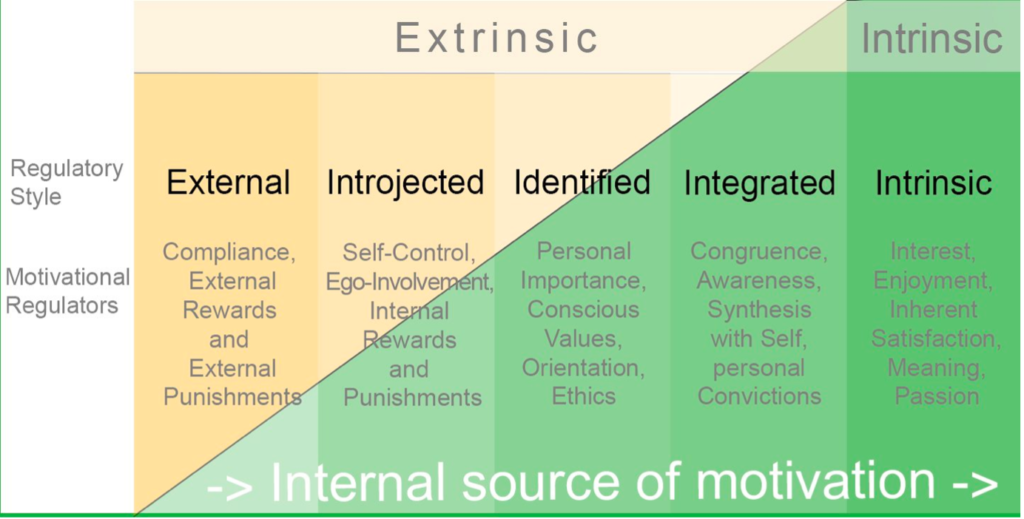This week we have a very special guest featuring on our Reading Mate Blog – Julie Keyes is an executive coach and consultant at The Educational Coach and we are delighted to share her insight. Throughout this blog Julie shares some terrific insights on motivation and monitoring progress with your child’s reading.
So, what is the impact of reading motivation and how are we monitoring progress in reading?
The love of reading – a phrase often used when describing a child with their head buried in a book. It’s a romantic idea, a notion that may well come from the stories held within the bindings of the great novels themselves.
But for many children, the motivation to read doesn’t come down to pure emotion. So how do we give them a little nudge in the right direction? Let’s get a bit science-y and look at how motivation works.
Consider a sliding scale from extra extrinsic motivation at one end to intrinsic motivation at the other. Put simply, is your drive due to external factors and a willingness for compliance, or an inherent joy, compelled by happiness and interest?
Extrinsic motivation introduces rewards and punishment from an external source. Conversely, intrinsic motivation is something you do for your own satisfaction. This could be seen as the holy grail for motivation when it comes to any activity we want our children to engage with.
However, there are three very important stages in-between these two motivational extremes:
• Introjected motivation – when you do something because you know it is the right thing to do. For example, you exercise because you know it is good for you
• Identified motivation – a factor of personal importance that aligns with your values and ethics
• Integrated motivation – this includes the influence of role models and the impact of self awareness
Let’s take this back to reading. Intrinsic motivation is the ultimate goal. However, the reality can be a little different. For the most part, engagement in reading in schools and with parents is built on extrinsic motivation – an external system that only rewards ‘good’ readers.
Whilst the hope is that those extrinsic rewards will lead to a more intrinsic source of motivation for the child – and become the all-important ‘lover of reading’ – it’s important not to ignore those in-between stages. Stepping stones linking either end of the motivational scale offer the pathway to progression from external to internal sources of motivation.
To bring this to life with an example, let’s consider a child who only reads for reward, with a fear of punishment if they don’t.
How might you move them along the motivational scale?
Role modelling – seen in the identified and integrated motivational stages – may be the first port of call. When parents and teachers demonstrate an enjoyment of reading, a child may be compelled to emulate their role models. Parental engagement in reading from an early age increases the chances of children having better fluency and comprehension.
When considering this from a coaching point of you, questions to ask include:
• What do you enjoy about reading?
• Who do you know who really loves to read?
• Why do you think they like reading?
• How do they look when they read?
The five personality traits are also an interesting point of reference when considering how to motivate children to read. These traits are openness, conscientiousness, extroversion, agreeableness, and neuroticism.
The traits form parts of our personality that remain fairly constant throughout our lives. That being said, during childhood, these are far from set, and are often referred to as temperament rather than traits.
Identifying where a child is on each one of these trait spectrums helps you to understand how you might motivate a child to engage with reading. For example, a child who scores highly on openness may respond favourably to activities developing curiosity and inventiveness.
 The commonplace idea of wrapping books in brown paper and writing clues as to what the book might hold appeals to children who score highly on openness.
The commonplace idea of wrapping books in brown paper and writing clues as to what the book might hold appeals to children who score highly on openness.
By way of another example, children who score low on the scale of extroversion tend to prefer solitary activities and may present as more reserved. On the other end of the spectrum, high extroversion is demonstrated by an outgoing and energetic child. So, how might you present reading to individuals with each of these different personalities?
A child who is low on the extroversion scale will likely feel more comfortable reading alone to themselves or in their head. This may take place before bedtime when it is calm and quiet. Conversely, a child who is high on the extroversion scale may feed off the engagements they get from other people. They may prefer to read out loud with others as part of a group.
Coaching questions will allow for a better understanding of where a child sits on each scale of the personality traits. These will allow you to tailor your approach to increasing engagement and motivation.
To find out how to ask the right questions to engage your child and give them motivation to read, take a look at The Educational Coach website. Or send us a message – we’d love to chat!
See more posts for tips to help your learners who are having difficulty reading or are reluctant to engage with reading.

